CADILLAC SEVILLE 1994 4.G Owners Manual
Manufacturer: CADILLAC, Model Year: 1994, Model line: SEVILLE, Model: CADILLAC SEVILLE 1994 4.GPages: 399, PDF Size: 21.33 MB
Page 101 of 399
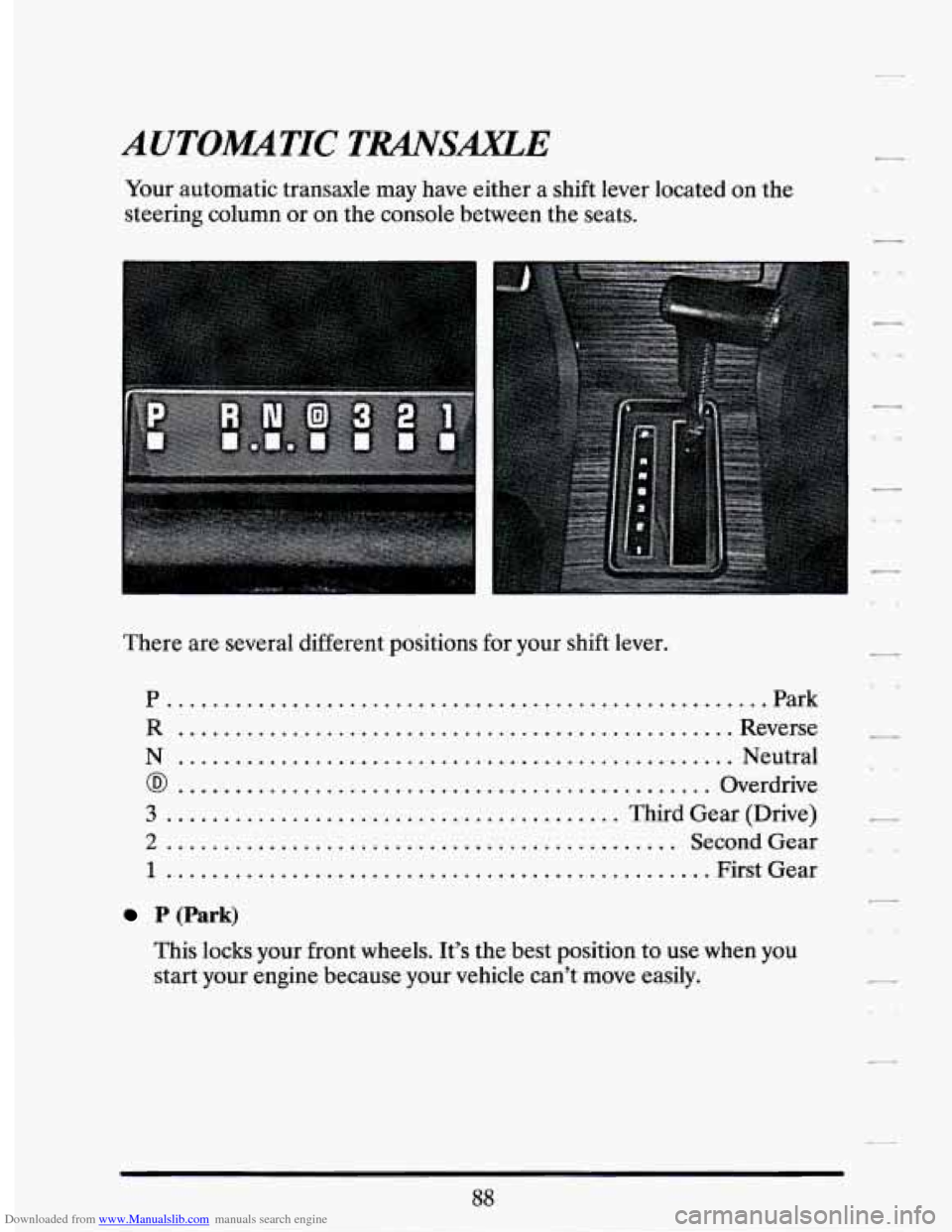
Downloaded from www.Manualslib.com manuals search engine AUTOMTIC TRANSAXLE
Your automatic transaxle may have either a shift lever located on the
steering column or on the console between the seats.
There are several different positions for your shift lever.
P.....................................................Park
R ................................................. Reverse
N ................................................. Neutral
@ ............................................... Overdrive
3 ........................................ Third Gear (Drive)
2............................................. SecondGear
1.......--.---..--- ..---- ...................... First Gear
P (Park)
This locks your front wheels. It’s the best position to use when you
start your engine because your vehicle can’t move easily.
88
cc
Page 102 of 399
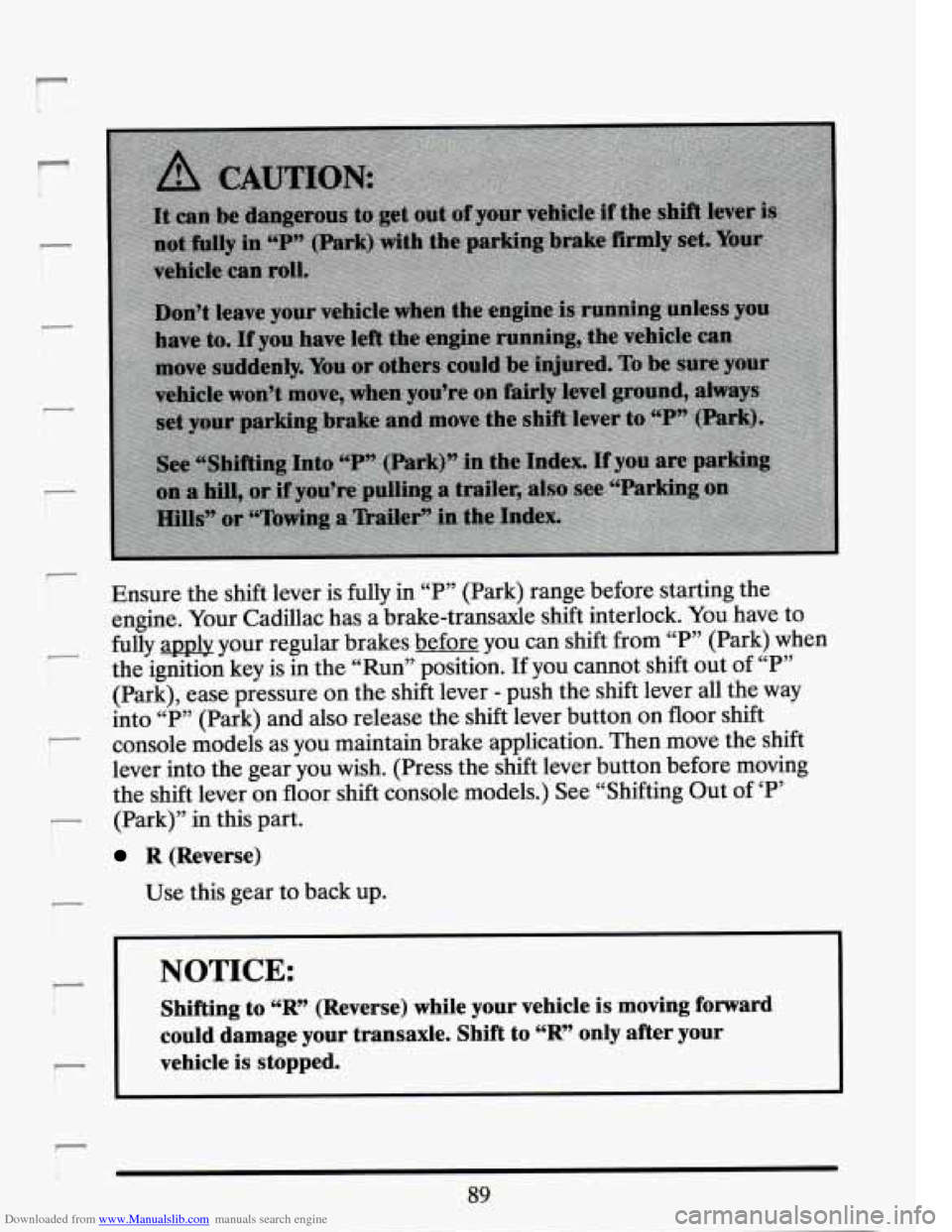
Downloaded from www.Manualslib.com manuals search engine r
-
- i
-
Ensure the shift lever is fully in “P7’ (Park) range before starting the
engine. Your Cadillac has a brake-transaxle shift interlock. You have to
fully apply your regular brakes before you can shift from ‘‘P” (Park) when
the ignition key is in the “Run” position.
If you cannot shift out of “P”
(Park), ease pressure on the shift lever
- push the shift lever all the way
into ‘‘P77 (Park) and also release the shift lever button on floor shift
console models as you maintain brake application. Then move the shift
lever into the gear you wish. (Press the shift lever button before moving
the shift lever on floor shift console models.) See “Shiftine Out of ‘P’
(Park)” in this part.
R (Reverse)
._
I
Use this gear to back up.
r
NOTICE:
Shifting to “R” (Reverse) while your vehicle is moving forward
could damage your transaxle. Shift to “R” only after your\
vehicle is stopped.
Page 103 of 399
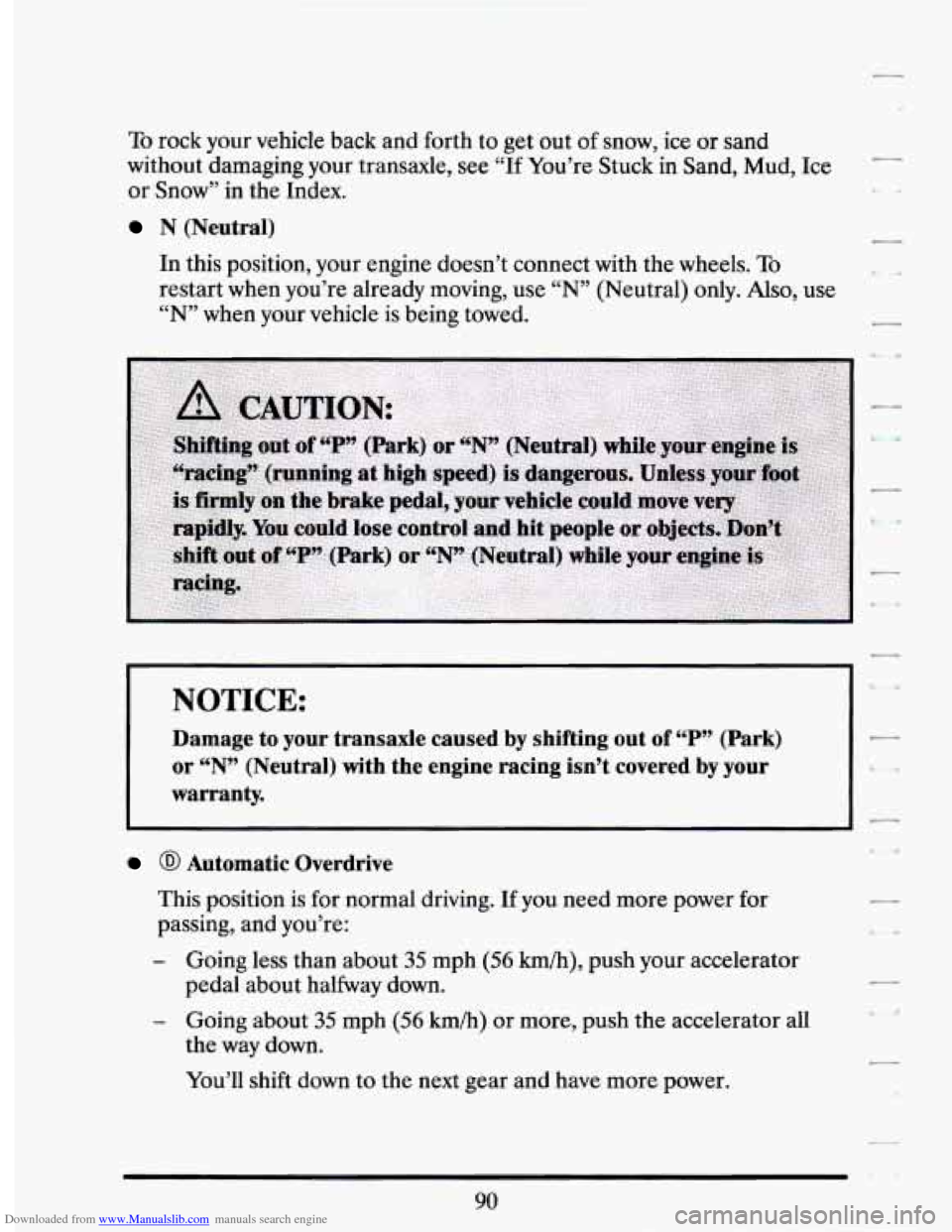
Downloaded from www.Manualslib.com manuals search engine To rock your vehicle back and forth to get out of snow, ice or sand
without damaging your transaxle. see “If You’re Stuck in Sand, Mud, Ice
or Snow” in the Index.
N (Neutral)
In this position, your engine doesn’t connect with the wheels. To
restart when you’re already moving, use “N” (Neutral) only. Also, use
“N’ when your vehicle is being towed.
I
NOTICE:
Damage to your transaxle caused by shifting out of “P” (Park)
or “N” (Neutral) with the engine racing isn’t covered\
by your
warrantv. l-
@ Automatic Overdrive
This position is for normal driving. If you need more power for
passing, and you’re:
- Going less than about 35 mph (56 kmh), push your accelerator
pedal about halfway down.
- Going about 35 mph (56 km/h) or more, push the accelerator all
the way down.
You’ll shift down to the next gear and have more power.
90
Page 104 of 399
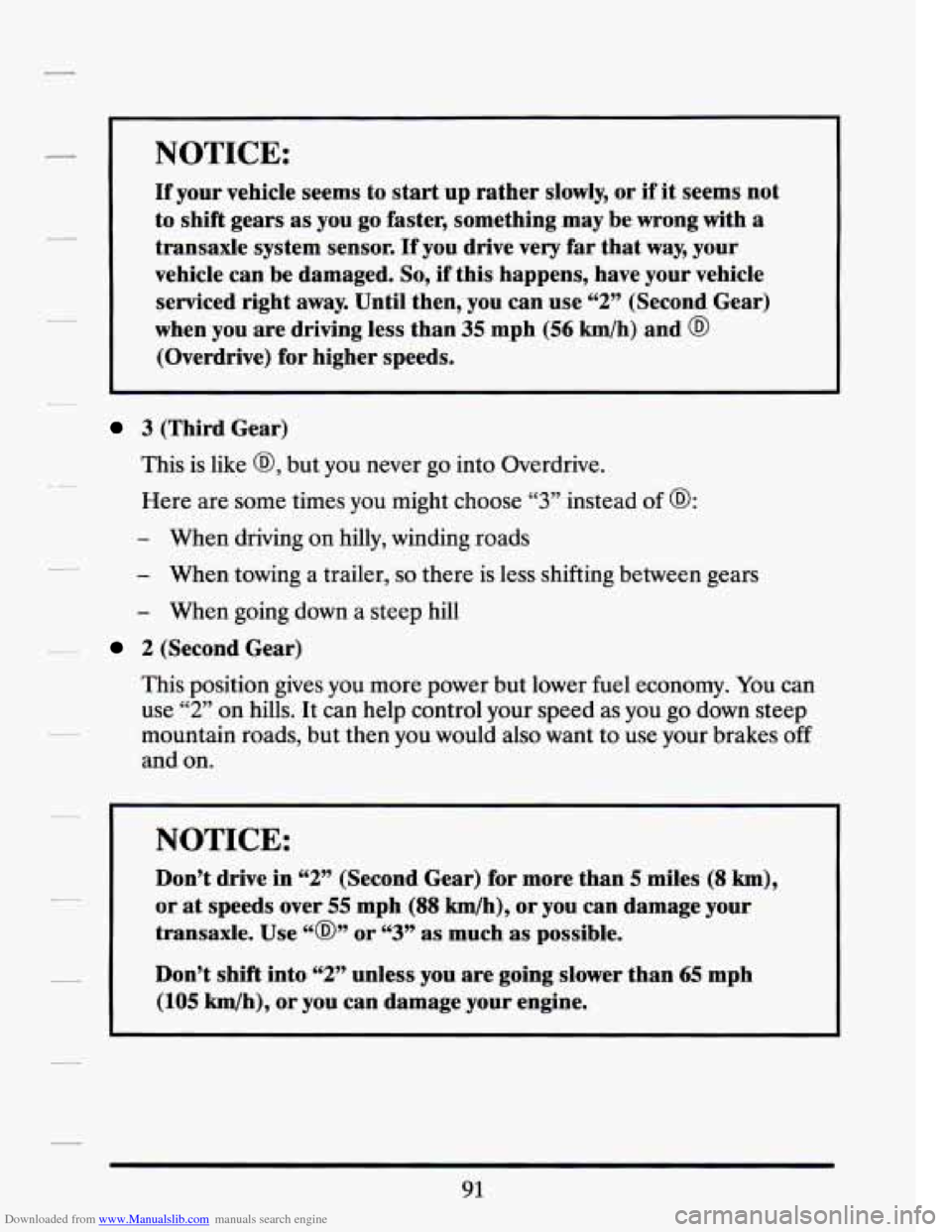
Downloaded from www.Manualslib.com manuals search engine NOTICE:
If your vehicle seems to start up rather slowly, or if it seems not
to shift gears
as you go faster, something may be wrong with a
transaxle system sensor. If you drive very far that way, your
vehicle can be damaged.
So, if this happens, have your vehicle
serviced right
away. Until then, you can use “2” (Second Gear)
when you
are driving less than 35 mph (56 km/h) and @
(Overdrive) for higher speeds.
3 (Third Gear)
This is like
@, but you never go into Overdrive.
Here are some times
you might choose “3” instead of 0:
- When driving on hilly, winding roads
- When towing a trailer, so there is less shifting between gears
- When going down a steep hill
2 (Second Gear)
This position gives
you more power but lower fuel economy. You can
use
“2” on hills. It can help control your speed as you go down steep
mountain roads, but then you would also want to use your brakes
off
and on.
NOTICE:
Don’t drive in “2” (Second Gear) for more than 5 miles (8 km),
or at speeds over 55 mph (88 km/h), or you can damage your
transaxle. Use
“@” or “3” as much as possible.
Don’t shift into
“2” unless you are going slower than 65 mph
(105 km/h), or you can damage your engine.
I
91
Page 105 of 399

Downloaded from www.Manualslib.com manuals search engine 1 (First Gear)
This position gives you even more power (but lower fuel economy)
than
“2.” You can use it on very steep hills, or in deep snow or mud. If
the selector lever is put in “1,” the transaxle won’t shift into first gear
until the vehicle is going slowly enough.
NOTICE:
If your front wheels can’t rotate, don’t try to drive. This might
happen
if you were stuck in very deep sand or mud or were up
against
a solid object. You could damage your transaxle.
I-
l-
Also, if you stop when going uphill, don’t hold your vehicle there
with only the accelerator pedal. This could overheat and
damage the transaxle. Use your brakes to hold your vehicle in
position on
a hill.
I
I --
PARKlNG BRAKE
To set the parking brake:
Hold the regular brake pedal
down with your right foot. Push down the
parking brake pedal with your left foot.
If the ignition is on, the brake
system warning light will
come on.
92
Page 106 of 399
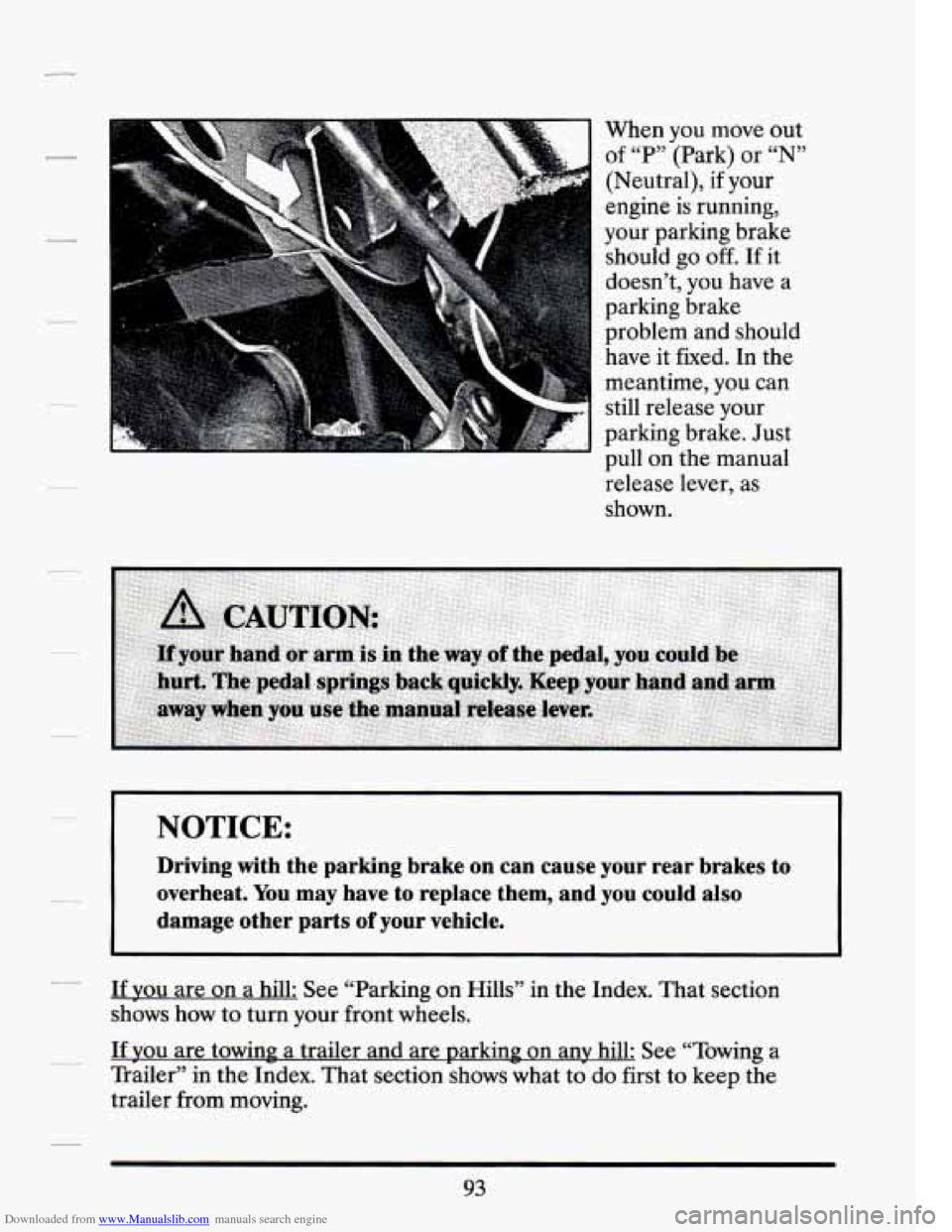
Downloaded from www.Manualslib.com manuals search engine When you move out
of “P” (Park) or
“N”
(Neutral), if your
engine is running,
your parking brake
should go
off. If it
doesn’t, you have a
parking brake
problem and should
have it fixed.
In the
meantime, you can
still release your
parking brake. Just pull on the manual
release lever, as
shown.
I NOTICE:
Driving with the parking brake on can cause your rear brakes to
overheat. You may have
to replace them, and you could also
damage other parts
of your vehicle.
If you are on a hill: See “Parking on Hills” in the Index. That section
shows how to
turn your front wheels.
If you are towing a trailer and are parking on any hill: See “Towing a
Trailer” in the Index. That section shows what to
do first to keep the
trailer from moving.
93
Page 107 of 399
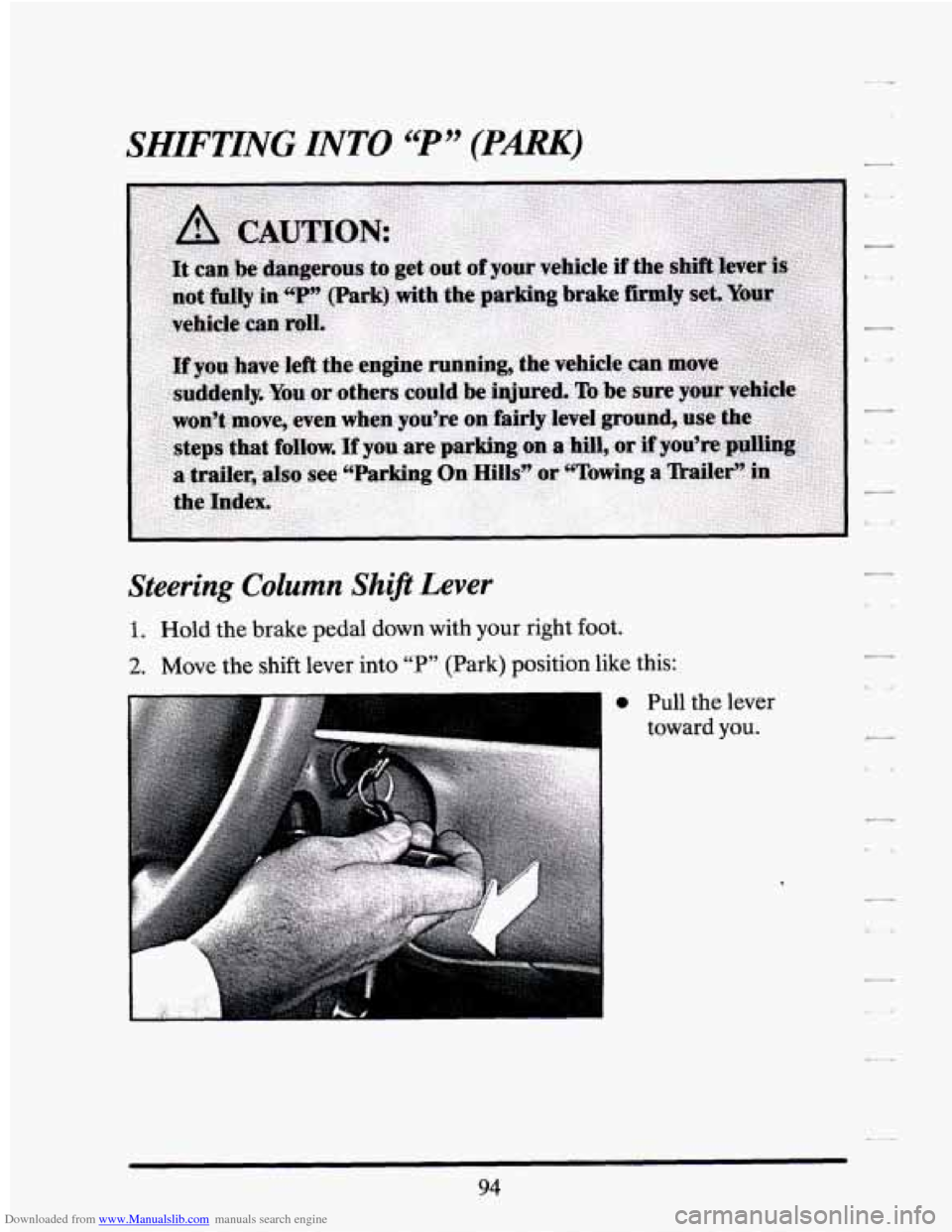
Downloaded from www.Manualslib.com manuals search engine SHIFTING INTO “P’’ (PARK)
Steering Column Shift Lever
1. Hold the brake pedal down with your right foot.
2. Move the shift lever into “P” (Park) position like this:
I
0 Pull the lever
toward you.
Page 108 of 399
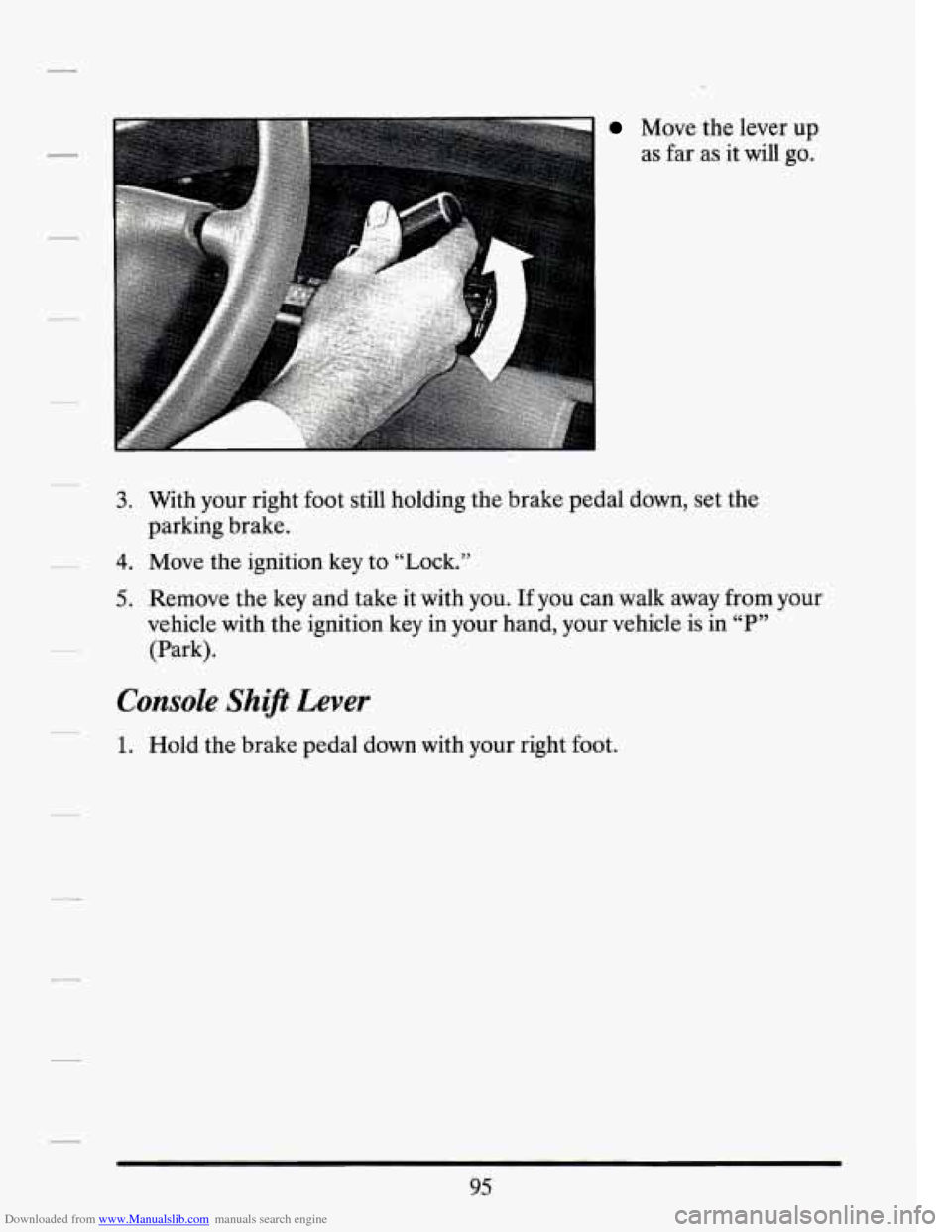
Downloaded from www.Manualslib.com manuals search engine Move the lever up
as far as it will go.
3. With your right foot still holding the brake pedal down, set the
4. Move the ignition key to “Lock.”
5. Remove the key and take it with you. If you can walk away from your
parking brake.
vehicle with
the ignition key in your hand, your vehicle is in
‘‘P”
(Park).
Console Shift Lever
1. Hold the brake pedal down with your right foot.
95
Page 109 of 399
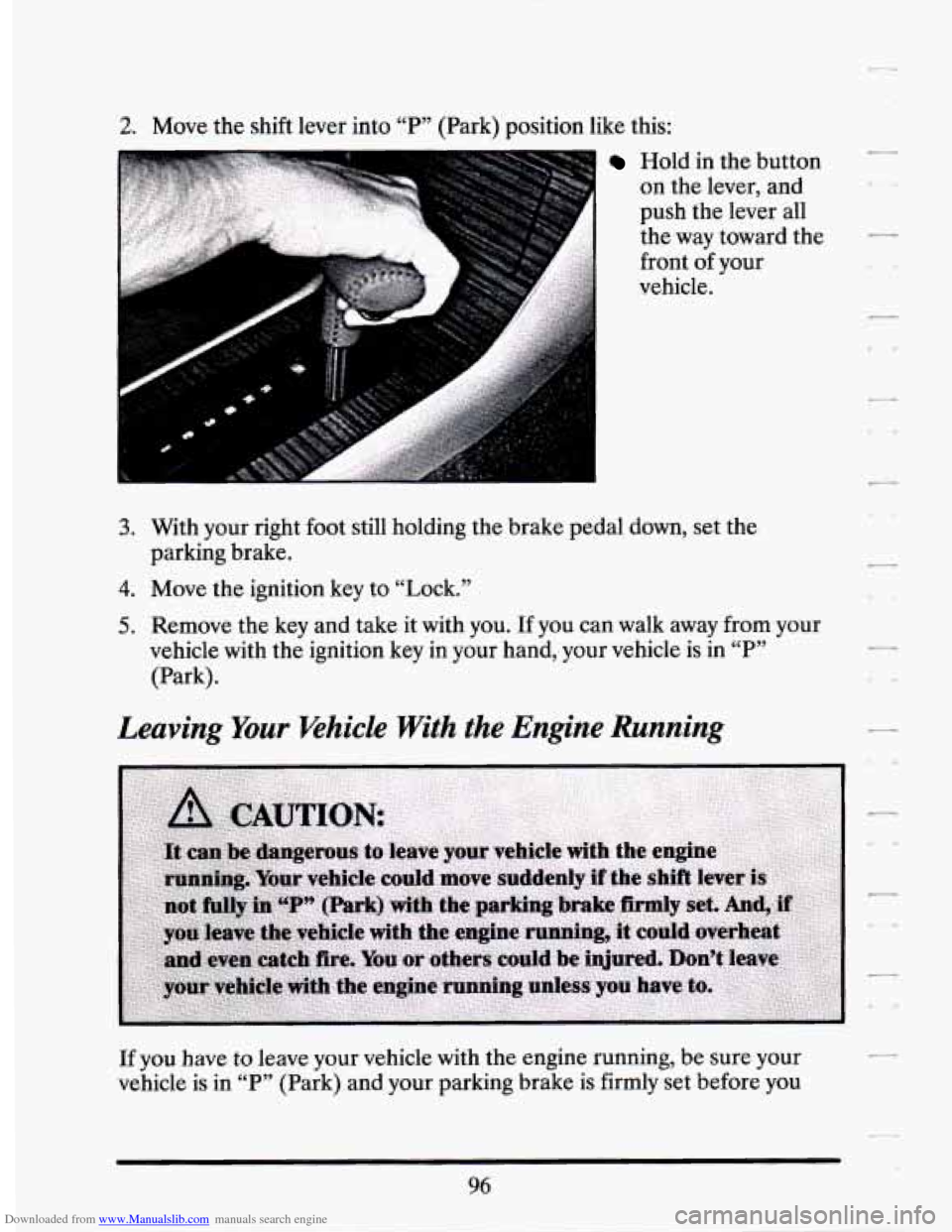
Downloaded from www.Manualslib.com manuals search engine 2. Move the shift lever into “P’, (Park) position like this:
1 Hold in the button
on the lever, and
push the lever all
the way toward the
front of your
vehicle.
3. With your right foot still holding the brake pedal down, set the
4. Move the ignition key to “Lock.”
5. Remove the key and take it with you. If you can walk away from your
parking brake.
vehicle with the ignition key in your hand, your vehicle is in
“P”
(Park).
Leaving Your Whicle With the Engine Running
If you have to leave your vehicle with the engine running, be sure your
vehicle is in
“P” (Park) and your parking brake is firmly set before you
96
Page 110 of 399

Downloaded from www.Manualslib.com manuals search engine leave it. After you’ve moved the shift lever into the “P” (Park) position,
hold the regular brake pedal down. Then, see
if you can move the shift
lever away from “P” (Park) without first pulling it toward you (or, if you
have the console shift lever, without first pushing the button).
If you can,
it means that the shift lever wasn’t fully locked into “P7’ (Park).
SHIFTING OUT OF “P” (PARK)
Your Cadillac has a brake-transaxle shift interlock. You have to fully
apply your regular brake before you can shift from “P” (Park) when the
ignition is in the “Run” position. See “Automatic Transaxle” in the Index.
If you cannot shift out
of “P’7 (Park), ease pressure on the shift lever --
push the shift lever all the way into “P” (Park) and also release the shift
lever button on floor shift models
as you maintain brake application.
Then move the shift lever into the gear you want. (Press the shift lever
button before moving the shift lever.) If you ever hold the brake pedal
down but still can’t shift out of “P” (Park),
try this:
1. Turn the key to “Off.” Open and close the driver’s door to turn off the
2. Apply and hold the brake until the end of Step 4.
3. Shift to “N” (Neutral).
Retained
Accessory Power feature.
4. Start the vehicle and then shift to the drive gear you want.
5. Have the vehicle fixed as soon as you can.
Torque Lock (Automatic Transaxle)
If you are parking on a hill and you don’t shift your transaxle into “P”
(Park) properly, the weight
of the vehicle may put too much force on the
parking pawl in the transaxle. You may find it difficult to pull the shift
lever out
of “P” (Park). This is called “torque lock.” To prevent torque
lock, always
be sure to shift into “P” (Park) properly before you leave the
driver’s seat. To find out how, see “Shifting Into ‘P’ (Park)” in the Index.
If “torque lock” does occur, you may need to have another vehicle push
yours a little uphill to take some
of the pressure from the transaxle, so
you can pull the shift lever out of “P” (Park).
97